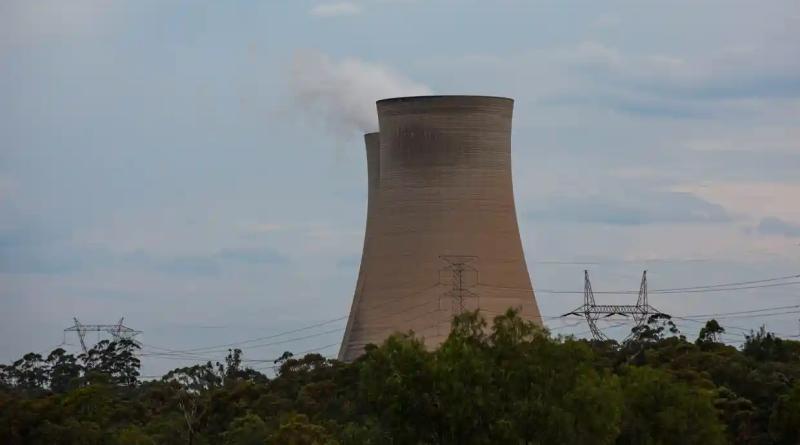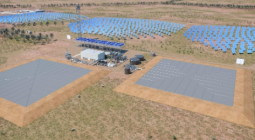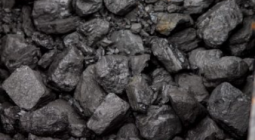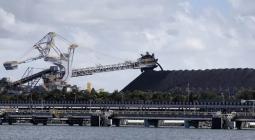AGL brings forward closure date of two largest coal-fired power plants as market shifts to renewables

Climate groups dismiss energy giant’s amended schedule for Loy Yang A and Bayswater as a ‘token effort’ that is ‘next to meaningless’
Energy giant AGL has accelerated the closure date of its two biggest coal-fired power plants by several years, responding to a market shift towards renewable sources of electricity.
In an earnings statement on Thursday to the ASX, the soon-to-be-demerged energy company said its underlying first-half profit after tax fell 40.9% to $194m compared with a year earlier. Revenue rose 5% to $5.713bn.
The main interest for many, though, will be the acceleration of the closure plans for AGL’s Hunter Valley-based Bayswater black coal-fired power station in New South Wales to “no later than” 2033 from its previously scheduled demise of 2035, while its brown coal-fired Loy Yang A plant in Victoria will now close by 2045 rather than 2048.
The timing of the closures, though, will depend on “the readiness of the entire energy system to operate without our critical baseload generation”, the company said.
Market forces, though, may decide on a much earlier closure date than these revised schedules. The company gives a nod to that, providing “closure windows” of 2030-33 for Bayswater and 2040-45 for Loy Yang A.
Worries about energy shortages have lately pushed up the cost of coal and gas globally, some of which has begun affecting wholesale power prices in Australia despite the falling share of fossil-fuel sources in the main national market. Wind, solar and hydro plants, whose energy costs are nearly free, generated almost a third of the electricity for eastern states in 2021.
One of Australia’s oldest companies, AGL generates about one-fifth of the National Electricity Market’s power, with about 11,000 megawatts of capacity. By the end of this financial year, it plans to split into two, with most of the generation units going into its Accel Energy spin-off, and the retailing arm to make up AGL Australia.
AGL’s Liddell plant, also in the Hunter, remains on track to close in April 2023, soon after the NSW state elections in March.
AGL said the timetable would lop emissions by 18-27% during the 2025-2045 period, compared with 2019 levels. Over the 2035-2046 period, those emissions would be 55-60% lower.
“Our aim, by transforming our business, is not only to better address our own climate related risks, but also to take a key leading role in enabling Australia’s energy transition, creating long-term value and sustainable investment opportunities as we do it,” Graeme Hunt, AGL’s chief executive, said on an analysts’ call. “The energy transition and the path to net zero [emissions] will be the defining challenge of our era.”
The company touted AGL as having the largest portfolio of renewable generation and battery assets of any ASX-listed company, with $4.8bn invested in renewables and similar assets over the past two decades.
The plan to accelerate the plant closures amounts to “a significant contribution to Australia’s energy sectors’ decarbonisation process, with the possibility of improvement beyond this if Accel Energy is able to bring closure dates further forward within the closure ranges”, Hunt said.
But Greenpeace Australia dismissed AGL’s amended schedule for Loy Yang A and Bayswater as a “token effort”.
“AGL doesn’t even get a golf clap for its timid token effort in delaying the closure timeline for Loy Yang A, Australia’s worst-polluting coal-burning power station, to 2045,” said Glenn Walker, a senior campaigner at Greenpeace Australia Pacific.
“In delaying Loy Yang A and Bayswater’s inevitable closure, AGL is putting worker and investor security, as well as the climate, at serious risk,” Walker said.
“Loy Yang A and its attached brown coalmine pump out over 20m tonnes of climate pollution every year,” he said. “Keeping this brown-coal blight on our climate open until 2045 will produce a further 460m tonnes of toxic emissions, equivalent to the [annual] pollution from over 100m cars, putting Australia’s chance at a safer climate future in jeopardy.”
In a sign that pressure to force Accel to speed up the plant closures is unlikely to abate, Dan Gocher, director of climate and environment at the Australasian Centre for Corporate Responsibility, said the timetable ignored “the majority of its shareholders with its failure to align the closure of its coal-fired power stations with the Paris agreement”.
“Just five months ago, 53% of AGL shareholders supported a motion calling for Paris-aligned targets for both demerged entities,” Gocher said. “The AGL board has manifestly failed to heed that message.”
The updated plan “is next to meaningless for these crumbling assets: in 2033, Bayswater will be 48 years old, and in 2045, Loy Yang A will be 61 years old”, he said.
“AGL is facing increasing sustaining capital expenditure on its coal-fired power stations (up $17m to $162m), while it steadfastly refuses to invest in the transition, with growth and transformation capital expenditure declining (down $18m to $62m),” Gocher said.
The federal energy minister, Angus Taylor, though, did not welcome the earlier closure times, saying the closure windows “leave a considerable gap of close to 5000MW of reliable generation in the National Electricity Market”.
“While this announcement is a commercial decision and AGL has complied with the minimum 3.5-year notice period, the exit of such a considerable amount of reliable generation is a concern for the continued reliability and affordability of the system,” Taylor said.
“Delivery of new, timely, replacement dispatchable capacity will be critical in keeping prices low and the lights on,” he said.
AGL’s shares were up as much as 3% in early trade on the ASX, before giving up the gains and ending down 3.5% at $7.27.
Nicholas Chapman, vice president, Moody’s Investors Service, said the weak half-year results were in line with market expectations and rising wholesale energy prices were likely to “stabilise” the company’s performance.
“However, the improved near-term outlook is overshadowed by persistent longer term challenges, including the continued entry of low cost renewables and structurally lower consumer energy demand,” Chapman said. “In addition, the company’s planned demerger of its retail business in the face of [environmental, social and government] pressures will reduce diversification and increase its exposure to carbon transition risk.”
cover photo: AGL’s Hunter Valley-based Bayswater black coal-fired power station. Its scheduled closure has been brought forward to 2033 from 2035. Photograph: Jessica Hromas/The Guardian





